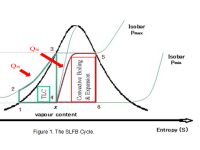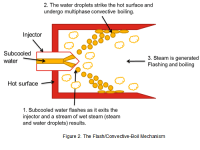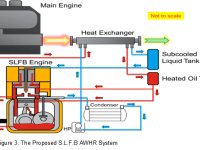Introduction.
The ideal Automotive Waste Heat Recovery (AWHR) system needs to be compact, cheap to mass produce and ultimately provide an efficiency improvement that significantly outweighs its cost.The proposed AWHR system operates on a novel heat cycle termed the SLFB cycle and is capable of being produced cheaply with currently available mass produced components.
The SLFB Cycle
The SLFB Cycle is an augmented version of Power Flash Cycles such as the Trilateral Cycle (TLC). In a conventional power flash cycle, an expandable vapour is generated through "Flashing." However, the liquid or unflashed portion which possesses a significant amount of heat energy is discarded as it cannot contribute to expansion work. The SLFB Cycle harnesses this energy by inducing multiphase convective boiling on this unflashed liquid portion. The multiphase convective boiling generates additional expandable vapour and supplements the work output of the cycle. (Figures 1,2)
The Key benefits of the SLFB Cycle
1. In a conventional heat exchanger of a Rankine cycle(RC), phase change occurring within the heat exchanger destroys potential work or exergy, and reduces the effectiveness of the heat exchanger. In the SLFB cycle, heat is transferred at pressures high enough to prevent phase change of the working fluid which results in a more efficient heat exchanger.
2. In the SLFB, the heat transfer in the “Flash” phase change process involves internal heat transfer within the working fluid eliminating heat transfer losses that would occur in a RC heat exchanger.
3. The SLFB heat exchanger uses a subcooled liquid working medium so has a much smaller volumetric flow rate than the RC, making it compact.
4. The SLFB Cycle is inherently more efficient than other power flash cycles as it harnesses the heat of the unflashed liquid portion which other power flash cycles discard.
5. No heat is lost from the working fluid in the heated SLFB expander.
6. The SLFB cycle is more efficient at power generation than a RC of comparable size when compactness is key.
7. The SLFB cycle engine has good transient response.
8. The SLFB WHR system allows energy storage for on-demand use.
The SLFB Automotive Waste Heat Recovery System
The SLFB cycle piston engine system involves controlled injections of high temperature subcooled liquid onto an appropriately heated surface. "Flashing" generates an expandable vapour and any unflashed liquid undergoes convective boiling off an appropriately heated boiling Surface (HBS). The vapour generated then expands in a heated piston expander. The system employs a heat exchanger which uses exhaust gasses and/or coolant to generate the subcooled working fluid and the heat transfer fluid for heating the "HBS" and any engine components which the expanding vapour comes in contact with. It also includes a storage for the heat transfer fluid and the subcooled working fluid to allow energy storage for on-demand delivery of power from the system (Figure 3). Experimental results show that an SLFB cycle AWHR system operating at maximum efficiency can theoretically improve the efficiency of an automotive gasoline IC engine by up to 8%.
Like this entry?
-
About the Entrant
- Name:Dhaminda Hewavitarane
- Type of entry:individual
- Patent status:patented








